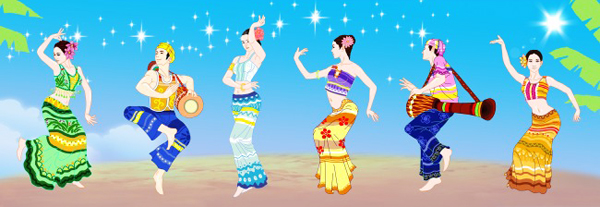The Dai are renowned throughout China for the grace, poise and elegance that they employ in their performances. From the ethereal Peacock Dance through to the lively Elephant-Foot Drum Dance, both men and women take part in this vibrant tradition. Performances will be accompanied by a variety of instruments, including the lusheng[1], bronze gong, clarinet, and hulusi[2], but none are as important as the elephant-foot drum. This indigenous instrument has played a focal role in Dai festivals for decades and its history is intrinsically linked with that of the Dai people.
According to legend, in ancient times the homeland of the Dai people was frequently subjected to severe flooding. These floods destroyed many homes and killed many people, and it was not long before the locals learned that a nearby dragon was responsible for these disasters. A brave Dai youth, accompanied by his fellow villagers, went out into the forest and slay the dragon. The dragon’s body was stripped of its hide and its skin was stretched over a hollowed out log to form a special drum, which was gifted to the youth in honour of his courage. Though no elephants were strictly involved, the unusual shape of this large drum earned it the name “elephant-foot drum”.
Nowadays the drum is made using hollowed out tree trunks or logs that have been covered in sheep skin or cowhide, since dragon skin is somewhat hard to come by. It is then painted and ornamented in peacock feathers. It can be long, medium-length, or short depending on the sound desired, as each drum can only produce one note. Originally they were covered in python skin but the potential endangerment of that animal warranted the change. A strap is attached to the drum that allows the performer to sling the instrument over their shoulder and beat it with their right hand as they dance, using their left hand to steady or shift it. Like a herd of Asian elephants trampling through the rainforest, the elephant-foot drum makes up for its lack of sound variety by being incredibly loud!
In keeping with the animal theme, the most famous performing art among the Dai is that of the Peacock Dance. The Dai revere the peacock as a symbol of happiness, beauty and kindness, and it appears that, according to local legend, this colourful bird was also once a devout Buddhist! In ancient times, the peacock was neither beautiful nor particularly colourful, and its tail fathers did not possess the characteristic “eyes” that they are known for today. It was a tame and obedient animal that lived a simple life.
One year, word spread that Buddha himself would descend to earth and grace the local temple with his presence during the Baipala Festival. Meanwhile, in a remote mountainous region far away, a peacock learned of the news. This peacock happened to be a Buddhist and so flew for miles and miles to reach the temple. Fortuitously, its arrival happened to coincide with that of Buddha’s! Unfortunately throngs of worshippers had already rushed to the temple and it was so overcrowded that the peacock could not get a decent view. In its agitation, it began pacing back and forth behind the crowd.
At that moment, Buddha noticed the anxious peacock and cast a beam of light in its direction, lighting it up in iridescent splendour and creating the many “eyes” along its tail feathers. As Buddha prepared to depart, he turned to the peacock and told it that they would meet again. Thereafter every time Buddha descended to earth during the Baipala Festival, he would first meet with his human worshippers at the temple and then go to the remote mountain where the peacock lived. There he would watch the peacock prance, dance, and show off its beautiful tail. It was the peacock’s dedication to Buddha that earned it such beauty and so, during major festivals, the Dai perform the Peacock Dance in its honour.
The dance is characterised by its use of undulating arm and torso movements. Several of the steps aim to imitate peacock behaviour, such as strolling, looking for water, peering intensely, bathing, drying the wings, spreading the tail feathers, and flying the nest, and these set movements are punctuated by free-form dance moves chosen by the performer. The clothes are normally patterned after the peacock’s tail feathers and endow the dancer with an otherworldly beauty.
[1] Lusheng: A wind instrument made of multiple bamboo pipes, each fitted with a free reed, that are all in turn fitted into a large, hardwood pipe. Normally there are five or six bamboo pipes that are each of a different pitch. Air is blown into the hardwood pipe to create sound. They vary in size from small, handheld ones to ones that are several metres in length.
[2] Hulusi: Also known as the cucurbit flute or “bilangdao” in the Dai language. It is a Chinese free reed wind instrument made up of three bamboo pipes attached to a gourd-shaped wind chest. The central pipe has finger holes, while the two outer pipes act as drone pipes, and air is blown into a mouthpiece at the front of the wind chest.
